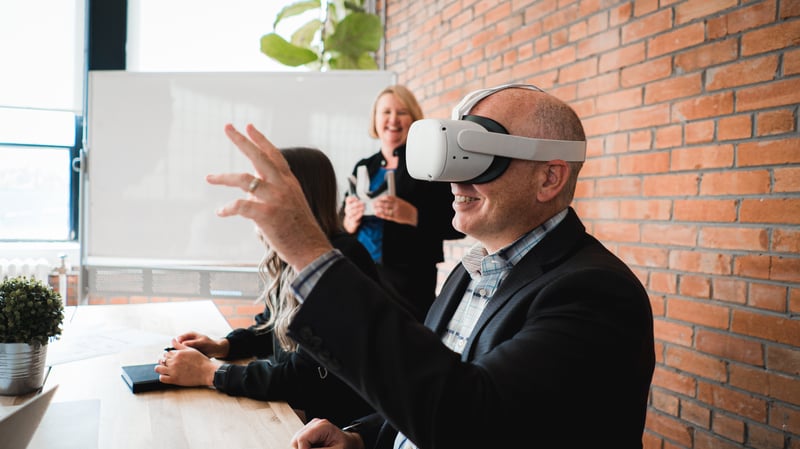In the world of architecture, effective communication with clients is crucial for successful project outcomes - and saving time along the way. However, conveying complex design concepts to clients who don’t have a design or technical background can be challenging. Many have trouble translating plans or 2D renderings into physical space in their heads. Finding a way to bridge the gap between the architect's vision and the client's understanding is essential. This is where the power of virtual reality (VR) and augmented reality (AR) comes into play, and is part of why Yulio VR was created - we’ve always been about sharing your vision. VR for Architecture should be about visual storytelling and design, and not about technology alone. If you haven’t tried using VR for Client Communication, you will be amazed at the level of trust and interaction VR presentations can build.
What VR Client Communication Can Do:
Architectural visualizations have long been relied upon to help clients visualize and comprehend designs. However, traditional renderings often lack the immersive experience needed to truly bring a design to life. Enter VR and AR technologies, which revolutionize the way architectural projects are presented and understood.
VR, in particular, offers a remarkable solution for architects seeking to enhance client communication. By creating realistic, three-dimensional environments, VR allows clients to step into a virtual representation of their future space. They can explore the design from every angle, gaining an unprecedented understanding of the spatial relationships, lighting conditions, and overall ambiance. Many of our clients find that VR client communication is especially valuable in showing the size and scale of a project - many people have trouble understanding the visual difference in 18’ vs 24’ etc. That evaporates when someone is inside a design.

Another advantage of VR client communication is its ability to showcase how a project integrates with its surroundings. By incorporating real-world data and 3D modeling, architects can create virtual environments that accurately reflect the context in which the building will exist. Clients can witness how their project harmonizes with the existing landscape, neighboring structures, and even the view from certain windows. This immersive experience fosters a deeper connection between the client and the design, instilling confidence and trust in the architect's vision.
Additionally, VR empowers clients to evaluate the functionality and adaptability of the design. They can interact with virtual elements such as furniture, fixtures, and finishes, giving them a tangible sense of how the space will accommodate their needs. This level of engagement allows clients to provide valuable feedback and make informed decisions regarding design modifications. By actively participating in the design process, clients become invested stakeholders, ensuring that the final product aligns with their expectations.
When to Use VR Client Communication
One common challenge architects face is striking a balance between presenting multiple design concepts and delving too deeply into details too early. This delicate equilibrium becomes even more critical when considering the time and resources involved in generating VR for your clients. That’s why you need something simple to use that works with your tools and workflow - and which lets you create VR for clients at different levels of fidelity.
Yulio offers the ability to render your Revit project with our free plugin and generate a fully navigable VR project with just a few clicks This efficiency not only saves time but also ensures that any member of your team who knows Revit can present in VR.
Incorporating VR into client interactions offers numerous opportunities to enhance the architectural design process. Firstly, utilizing VR allows architects to create a portfolio that truly stands out. By showcasing immersive virtual experiences of past projects, architects can captivate potential clients and leave a lasting impression. The ability to demonstrate their capabilities for VR client communication with this cutting-edge tool also gives architects a competitive advantage when presenting proposals in Request for Proposals (RFPs), increasing the likelihood of winning new business.

Moreover, VR enables architects to present designs at different levels of fidelity throughout the project lifecycle. From initial concepts to detailed plans, architects can use VR (it it’s fast and easy to create) to provide clients with a comprehensive understanding of the design at each stage. This approach accelerates the decision-making process and fosters client engagement and sign-off at a faster pace. By ensuring that clients are involved and informed from the beginning, architects can minimize late-stage changes and deliver a final product that aligns with the client's expectations.
The ultimate goal of integrating VR into architectural client communication is to ensure client satisfaction throughout the project. By immersing clients in virtual environments and enabling them to explore and interact with designs, architects can foster a deeper level of understanding and eliminate any ambiguity or misinterpretation. This comprehensive comprehension leads to increased client happiness and a higher likelihood of meeting or exceeding their expectations.
By harnessing the capabilities of VR and AR, architects can go beyond traditional renderings and elevate the client experience. These technologies enable architects to showcase their designs with stunning realism, fostering a deeper understanding and appreciation from clients. Clients can truly immerse themselves in the design, gaining insights that words alone cannot provide.
Improving architectural client communication with VR and AR is a game-changer for the industry. By leveraging these technologies, architects can overcome the challenges of conveying complex designs to non-technical clients. VR's immersive environments let clients to visualize their projects with unparalleled clarity and make informed decisions. By embracing VR and AR, architects can create a stronger bond of trust with their clients, resulting in better designs and successful outcomes.
Try it out with Yulio!







